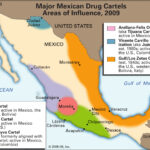Are you curious about the winter homes of the monarch butterflies and their connection to Mexico, especially as an LGBTQ+ traveler? The monarch butterflies overwinter in the oyamel fir forests of central Mexico, a breathtaking sight you can witness with your own eyes. Discover more about this incredible migration and how you can plan a trip to see them with information from gaymexico.net. Explore eco-tourism, conservation efforts, and LGBTQ+-friendly travel options.
1. Why Do Monarch Butterflies Migrate to Mexico?
Monarch butterflies migrate to Mexico to escape the cold winters of North America, seeking the warmer climate and specific habitat conditions found in the oyamel fir forests. These forests provide a stable microclimate, protecting the butterflies from extreme temperatures and providing the humidity they need to survive. The migration is crucial for their survival, as they cannot survive freezing temperatures. This phenomenon draws nature enthusiasts and LGBTQ+ travelers alike, offering a unique opportunity to witness a stunning natural event.
1.1 What Are the Specific Habitat Requirements for Monarch Butterflies in Mexico?
Monarch butterflies require oyamel fir forests at high altitudes (typically between 8,000 and 12,000 feet) in central Mexico. These forests offer a specific microclimate: cool temperatures, high humidity, and protection from frost. The dense canopy of the oyamel fir trees acts as a blanket, preventing the butterflies from freezing. The availability of water is also crucial.
1.2 How Does the Migration Help the Monarchs Survive?
The migration allows monarch butterflies to escape the harsh winter conditions of Canada and the United States, where temperatures can drop below freezing. In the oyamel fir forests of Mexico, the climate is mild enough for them to conserve energy and survive for several months until the spring, when they begin their journey north to reproduce.
1.3 What are Some Threats to the Monarch Butterfly Migration?
The monarch butterfly migration faces several threats, including:
- Deforestation: Illegal logging and deforestation in the oyamel fir forests destroy the butterflies’ overwintering habitat.
- Climate Change: Changing weather patterns and extreme temperatures can disrupt the butterflies’ migration and breeding cycles.
- Habitat Loss: Loss of milkweed, the monarch caterpillars’ only food source, in the United States and Canada due to herbicide use and development.
- Pesticide Use: Exposure to pesticides can harm or kill monarch butterflies and caterpillars.
2. Where Exactly Do Monarch Butterflies Overwinter in Mexico?
Monarch butterflies primarily overwinter in the Monarch Butterfly Biosphere Reserve in the Transvolcanic Belt of central Mexico, specifically in the states of Michoacán and Mexico State. This reserve protects the oyamel fir forests that provide the ideal microclimate for the butterflies to survive the winter. Several sanctuaries within the reserve are open to the public, allowing visitors to witness this incredible natural phenomenon.
2.1 What is the Monarch Butterfly Biosphere Reserve?
The Monarch Butterfly Biosphere Reserve is a UNESCO World Heritage Site established in 1980 to protect the overwintering habitats of the monarch butterfly. It spans over 56,000 hectares and encompasses several sanctuaries where the butterflies congregate in massive colonies.
2.2 Which Sanctuaries Are Open to the Public?
Several sanctuaries within the Monarch Butterfly Biosphere Reserve are open to the public, including:
- Sierra Chincua: Known for its accessibility and stunning views.
- El Rosario: The largest and most popular sanctuary, often crowded but offering an unforgettable experience.
- Llano El Azafrán: A smaller, less crowded sanctuary with beautiful scenery.
- Cerro Pelón: The most remote sanctuary, requiring a longer hike but offering a more secluded experience.
- La Mesa: Known for good conservation, and community participation
2.3 What Can Visitors Expect When Visiting the Sanctuaries?
Visitors can expect to hike through the oyamel fir forests to reach the areas where the monarch butterflies congregate. The altitude can be challenging, so it’s essential to be in good physical condition and take it slow. Once you reach the colonies, you’ll be awestruck by the sheer number of butterflies clustered on the trees. The best time to visit is between November and March. Remember to respect the butterflies’ habitat by staying on marked trails and avoiding making loud noises.
3. When Is the Best Time to See the Monarch Butterflies in Mexico?
The best time to see the monarch butterflies in Mexico is from November to March, with the peak viewing season in January and February. During these months, the butterflies are concentrated in their overwintering colonies, creating a breathtaking spectacle. Arriving earlier in the season (November-December) or later (February-March) might offer a less crowded experience.
3.1 How Does the Weather Affect the Monarch Butterflies?
The weather plays a crucial role in the behavior of monarch butterflies. On sunny days, the butterflies are more active, flying around and warming themselves in the sun. On cloudy or cold days, they tend to cluster together on the trees to conserve heat.
3.2 What Time of Day Is Best for Viewing Monarchs?
The best time of day for viewing monarchs is typically mid-morning to early afternoon when the sun is out and the butterflies are most active. Avoid visiting on very cold or overcast days, as the butterflies will likely remain clustered and less visible.
3.3 Are There Any Special Events or Festivals During the Monarch Season?
Yes, several communities near the Monarch Butterfly Biosphere Reserve host festivals and events during the monarch season. These events often include cultural performances, local food, and educational exhibits about the monarch butterfly migration. Check with local tourism offices for specific dates and details.
4. How Can LGBTQ+ Travelers Plan a Trip to See the Monarch Butterflies in Mexico?
LGBTQ+ travelers can plan a safe and enjoyable trip to see the monarch butterflies by researching LGBTQ+-friendly accommodations and tour operators in nearby towns like Angangueo and Zitácuaro. Mexico City, a major hub for international travel, offers a vibrant LGBTQ+ scene and is a convenient starting point for your journey. Consider joining organized tours that prioritize sustainable tourism and support local communities.
4.1 What Are Some LGBTQ+-Friendly Destinations Near the Monarch Butterfly Biosphere Reserve?
While the immediate area around the Monarch Butterfly Biosphere Reserve is relatively rural, several LGBTQ+-friendly destinations are within a reasonable distance:
- Mexico City: Offers a thriving LGBTQ+ scene with numerous gay bars, clubs, hotels, and cultural events.
- Morelia: A beautiful colonial city with a growing LGBTQ+ community and several welcoming hotels and restaurants.
- San Miguel de Allende: Known for its artistic atmosphere and inclusive environment, attracting many LGBTQ+ travelers and expats.
4.2 Are There Any LGBTQ+-Owned or LGBTQ+-Friendly Tour Operators Offering Trips to the Monarch Sanctuaries?
Researching LGBTQ+-owned or LGBTQ+-friendly tour operators who prioritize safety, inclusivity, and sustainable tourism practices is highly recommended. While such tour operators might not be exclusively focused on monarch butterfly tours, they can offer customized itineraries that include visits to the sanctuaries along with other cultural and historical attractions in the region. Consider visiting gaymexico.net for resources and recommendations.
4.3 What Safety Precautions Should LGBTQ+ Travelers Take When Visiting the Monarch Butterfly Region?
While Mexico is generally becoming more LGBTQ+-friendly, it’s essential to be aware of local customs and attitudes, especially in more rural areas. Here are some safety precautions for LGBTQ+ travelers:
- Research local laws and customs: Familiarize yourself with the local laws and cultural norms regarding LGBTQ+ rights and expressions.
- Exercise discretion: While public displays of affection are becoming more accepted in larger cities, it’s best to exercise discretion in more conservative areas.
- Stay informed: Keep up-to-date on any travel advisories or safety concerns issued by your government or LGBTQ+ organizations.
- Trust your instincts: If you feel uncomfortable or unsafe in a particular situation, remove yourself from the situation.
- Utilize LGBTQ+ resources: Connect with local LGBTQ+ organizations or community centers for support and information.
5. What Is the Significance of the Oyamel Fir Forests for Monarch Butterflies?
The Oyamel fir forests are crucial for the survival of monarch butterflies because they provide a unique microclimate that protects the butterflies from extreme temperatures and desiccation during the winter months. The dense canopy of the fir trees acts as a natural insulator, maintaining relatively stable temperatures and humidity levels. Without these forests, the monarch butterflies would not be able to survive the winter.
5.1 How Do the Oyamel Fir Trees Protect the Monarch Butterflies?
The Oyamel fir trees protect monarch butterflies in several ways:
- Temperature Regulation: The dense canopy traps heat, keeping the temperature within the forest relatively stable, even when temperatures outside the forest drop below freezing.
- Humidity Control: The trees release moisture, maintaining high humidity levels within the forest, which prevents the butterflies from drying out.
- Wind Protection: The dense canopy blocks strong winds, preventing the butterflies from being blown away or damaged.
- Camouflage: The trees provide a natural camouflage for the butterflies, helping them blend in with their surroundings and avoid predators.
5.2 What Are the Threats to the Oyamel Fir Forests?
The Oyamel fir forests face several threats, including:
- Deforestation: Illegal logging and land clearing for agriculture destroy the forests and disrupt the microclimate that the butterflies need to survive.
- Climate Change: Changes in temperature and precipitation patterns can stress the trees, making them more susceptible to disease and pests.
- Illegal Mining: Mining activities can damage the forests and pollute the water sources that the trees need to survive.
5.3 What Conservation Efforts Are in Place to Protect the Oyamel Fir Forests?
Several conservation efforts are in place to protect the Oyamel fir forests, including:
- The Monarch Butterfly Biosphere Reserve: Provides legal protection for the forests and restricts logging and other activities that could harm the habitat.
- Reforestation Programs: Planting new Oyamel fir trees to restore degraded areas of the forest.
- Sustainable Tourism Initiatives: Promoting tourism that benefits local communities and encourages conservation efforts.
- Community-Based Conservation Programs: Involving local communities in the protection and management of the forests.
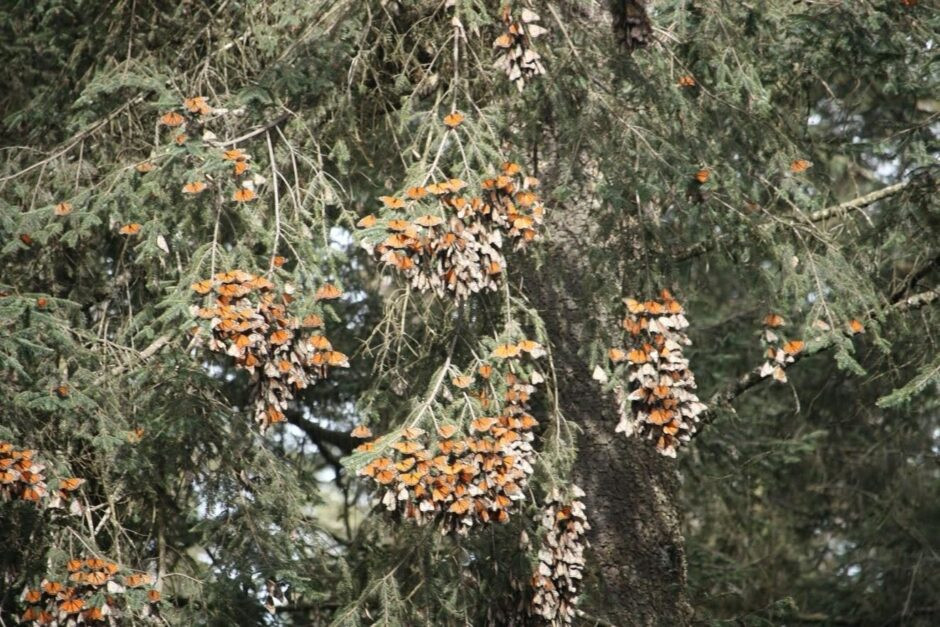 The sheer number of Monarchs is staggering, even though we know they are down from years past.
The sheer number of Monarchs is staggering, even though we know they are down from years past.
6. What Is the Life Cycle of the Monarch Butterfly and How Does the Migration Fit In?
The monarch butterfly has a fascinating life cycle that spans four generations, with the migration being a critical part of the fourth generation’s journey. The life cycle includes four stages: egg, larva (caterpillar), pupa (chrysalis), and adult butterfly. The migrating generation, known as the “Methuselah generation,” lives much longer than the other generations, allowing them to make the long journey to Mexico.
6.1 What Are the Four Stages of the Monarch Butterfly Life Cycle?
The four stages of the monarch butterfly life cycle are:
- Egg: The female monarch butterfly lays tiny eggs on milkweed plants, which serve as the sole food source for the caterpillars.
- Larva (Caterpillar): The caterpillar hatches from the egg and feeds voraciously on milkweed leaves, growing rapidly and molting several times.
- Pupa (Chrysalis): The caterpillar transforms into a chrysalis, a protective casing where it undergoes metamorphosis.
- Adult Butterfly: The adult butterfly emerges from the chrysalis, ready to reproduce and continue the cycle.
6.2 How Does the Migration Relate to the Monarch Butterfly’s Life Cycle?
The migration is primarily undertaken by the fourth generation of monarch butterflies, known as the “Methuselah generation.” These butterflies are born in late summer and early fall and are genetically programmed to migrate south to Mexico. They live for several months, unlike the other generations, which only live for a few weeks. After overwintering in Mexico, they begin the journey north in the spring, laying eggs along the way and starting the cycle anew.
6.3 What Is the Role of Milkweed in the Monarch Butterfly’s Life Cycle?
Milkweed is essential to the monarch butterfly’s life cycle because it is the only food source for the monarch caterpillars. The caterpillars ingest toxins from the milkweed, which make them poisonous to predators. Without milkweed, monarch butterflies cannot survive.
7. How Can I Help Protect Monarch Butterflies and Their Migration?
You can help protect monarch butterflies and their migration by planting milkweed in your garden, reducing your use of pesticides, supporting organizations that protect monarch habitat, and educating others about the importance of monarch conservation. Every action, no matter how small, can make a difference in helping these iconic butterflies survive.
7.1 What Can I Plant in My Garden to Help Monarch Butterflies?
Planting milkweed is the most important thing you can do to help monarch butterflies. Different species of milkweed are native to different regions, so choose a species that is native to your area. You can also plant nectar-rich flowers that will provide food for adult butterflies.
7.2 How Can I Reduce My Use of Pesticides?
Pesticides can harm or kill monarch butterflies and caterpillars. Reduce your use of pesticides by using natural pest control methods, such as introducing beneficial insects or using organic pesticides.
7.3 Which Organizations Support Monarch Butterfly Conservation?
Numerous organizations support monarch butterfly conservation, including:
- Monarch Joint Venture: A partnership of organizations working to protect monarch butterflies and their habitat.
- World Wildlife Fund: Works to protect the Monarch Butterfly Biosphere Reserve and promote sustainable tourism.
- National Wildlife Federation: Advocates for policies that protect monarch butterflies and their habitat.
- Xerces Society: Focuses on invertebrate conservation, including monarch butterflies.
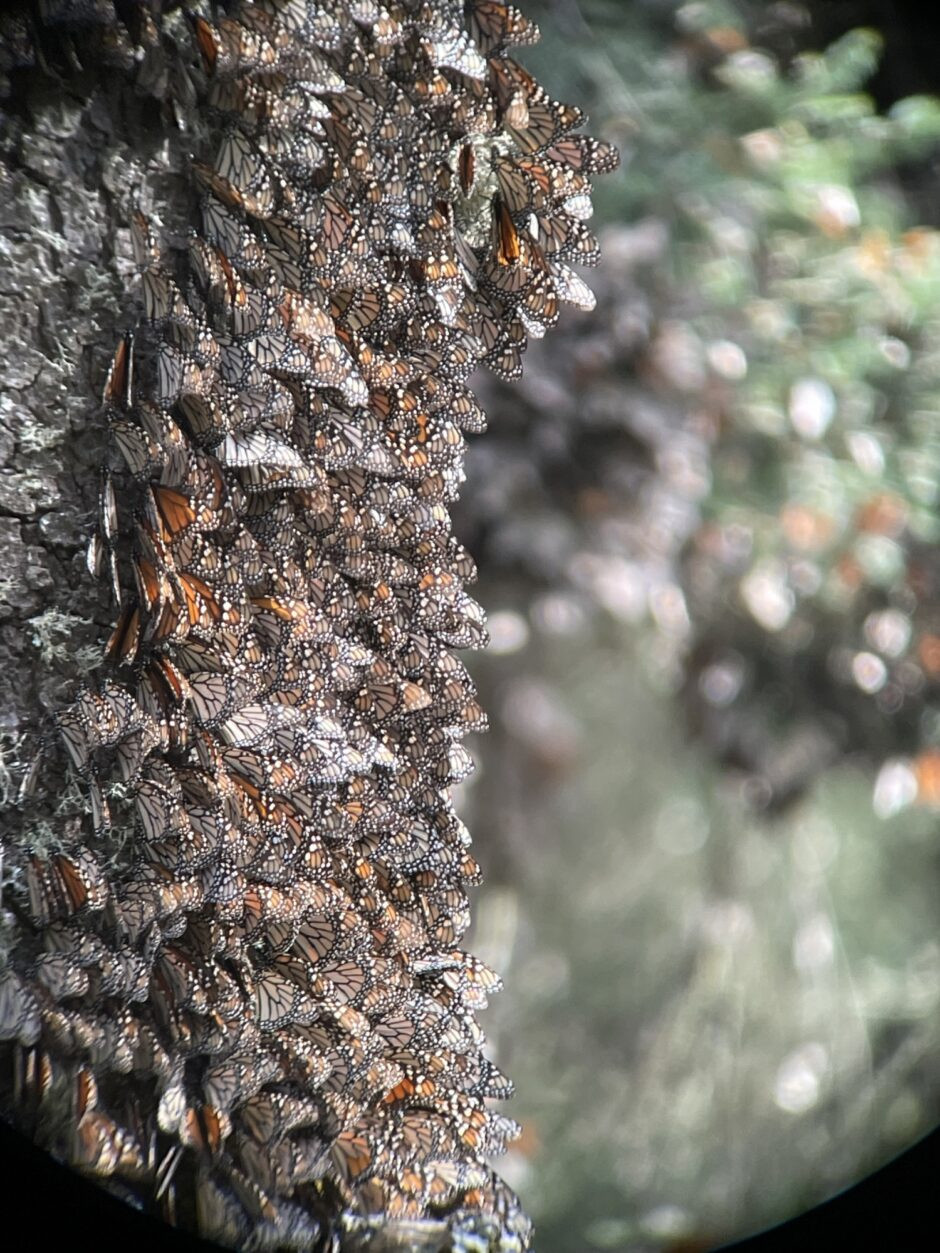 The detail, as seen through a spotting scope and photographed with my iPhone, is amazing!
The detail, as seen through a spotting scope and photographed with my iPhone, is amazing!
8. What Are Some Interesting Facts About Monarch Butterflies?
Monarch butterflies are truly remarkable creatures with many fascinating facts, including their ability to navigate thousands of miles using a “magnetic compass,” their bright colors serving as a warning to predators, and their incredible clustering behavior in the overwintering colonies. Learning more about these facts can deepen your appreciation for these incredible insects.
8.1 How Do Monarch Butterflies Navigate During Their Migration?
Monarch butterflies navigate using a combination of factors, including:
- The Sun’s Position: They use the sun as a compass, adjusting their flight path based on the time of day.
- Earth’s Magnetic Field: Monarchs have an internal magnetic compass that helps them orient themselves.
- Landmarks: They may also use landmarks, such as mountain ranges and coastlines, to guide their way.
8.2 Why Are Monarch Butterflies Poisonous to Predators?
Monarch caterpillars feed exclusively on milkweed, which contains toxins called cardiac glycosides. These toxins accumulate in the caterpillars’ bodies and remain in the adult butterflies, making them poisonous to predators. The bright orange and black colors of the monarch butterfly serve as a warning signal to predators, indicating that they are not palatable.
8.3 How Do Monarch Butterflies Cluster Together in Their Overwintering Colonies?
Monarch butterflies cluster together in their overwintering colonies to conserve heat and protect themselves from the elements. The clusters can contain thousands or even millions of butterflies, creating a stunning spectacle. The butterflies huddle together tightly, with the butterflies on the outside of the cluster rotating to the inside to share the warmth.
9. What Role Does Tourism Play in the Conservation of Monarch Butterflies?
Sustainable tourism can play a vital role in the conservation of monarch butterflies by providing economic incentives for local communities to protect the forests and by raising awareness among visitors about the importance of monarch conservation. Ecotourism initiatives that prioritize responsible travel practices can help ensure that tourism benefits both the butterflies and the local communities.
9.1 How Can Tourism Benefit Local Communities Near the Monarch Butterfly Biosphere Reserve?
Tourism can benefit local communities near the Monarch Butterfly Biosphere Reserve by:
- Providing Employment Opportunities: Tourism creates jobs in the hospitality, transportation, and guiding industries.
- Generating Income: Tourists spend money on accommodation, food, souvenirs, and other goods and services, which boosts the local economy.
- Supporting Small Businesses: Tourism provides opportunities for local entrepreneurs to start and grow small businesses, such as restaurants, craft shops, and tour companies.
- Promoting Cultural Preservation: Tourism can encourage the preservation of local traditions, crafts, and cultural heritage.
9.2 What Are the Principles of Sustainable Tourism in the Monarch Butterfly Region?
The principles of sustainable tourism in the Monarch Butterfly region include:
- Minimizing Environmental Impact: Reducing waste, conserving water and energy, and protecting natural resources.
- Respecting Local Culture: Honoring local traditions, customs, and cultural heritage.
- Supporting Local Communities: Hiring local guides, purchasing local products, and contributing to community development projects.
- Educating Visitors: Providing information about monarch butterflies, their habitat, and the importance of conservation.
- Promoting Responsible Travel Practices: Encouraging visitors to stay on marked trails, avoid disturbing the butterflies, and respect the local environment.
9.3 How Can Visitors Be Responsible Tourists in the Monarch Butterfly Sanctuaries?
Visitors can be responsible tourists in the Monarch Butterfly sanctuaries by:
- Staying on Marked Trails: Avoid wandering off the trails and disturbing the forest vegetation.
- Avoiding Loud Noises: Keep your voice down and avoid making loud noises that could scare the butterflies.
- Not Touching the Butterflies: Refrain from touching the butterflies, as this can damage their wings and disrupt their behavior.
- Not Using Flash Photography: Avoid using flash photography, as it can disturb the butterflies.
- Respecting Local Customs: Dress modestly and be respectful of local customs and traditions.
- Hiring Local Guides: Support local communities by hiring local guides to lead your tour.
- Purchasing Local Products: Buy souvenirs and other products from local artisans and businesses.
- Disposing of Waste Properly: Pack out all trash and dispose of it properly.
- Paying Entry Fees: By paying the entry fees, you are contributing to the funds that help maintain the sanctuary.
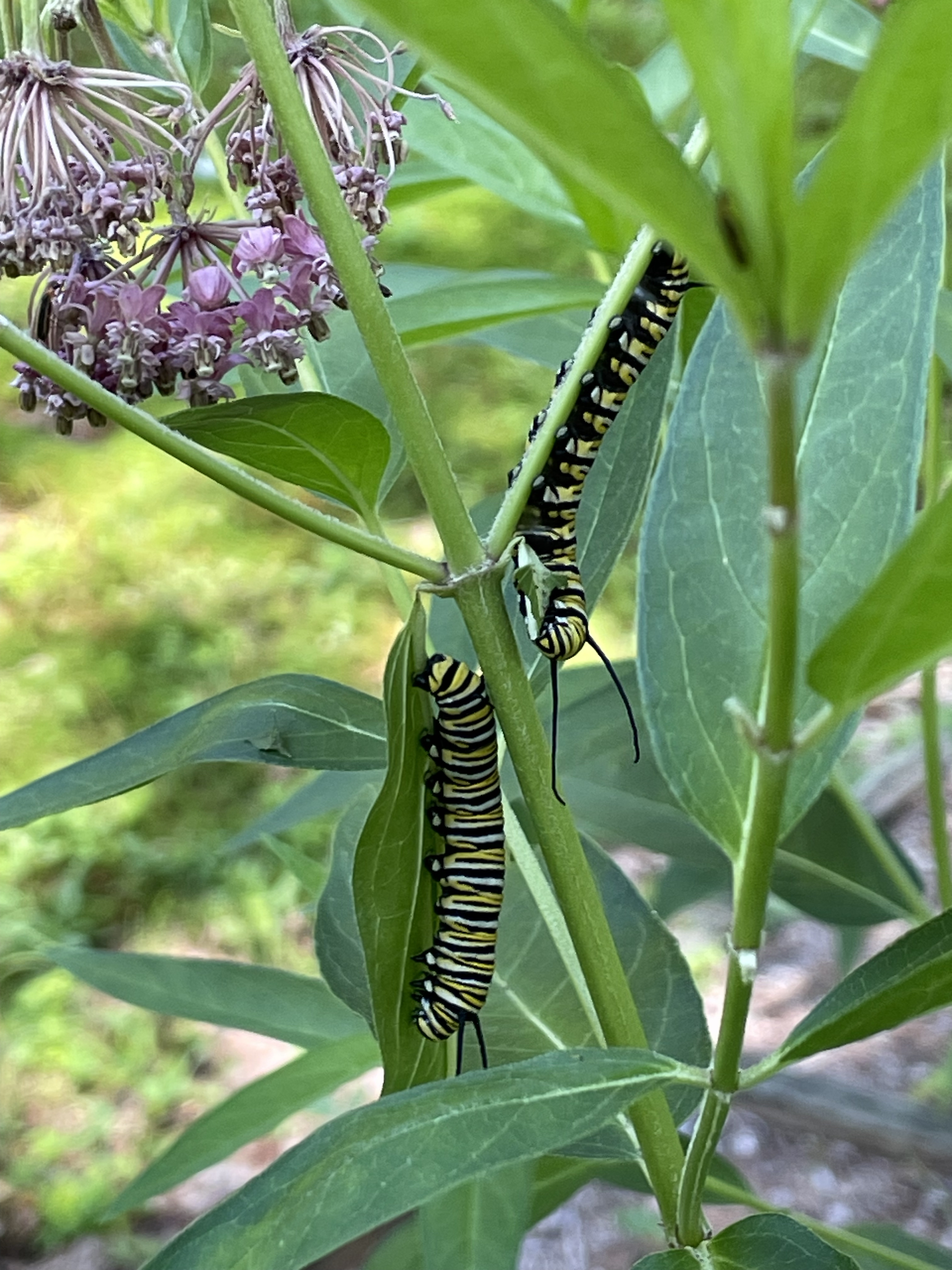 NH Monarch caterpillars in July 2024, getting ready for the next stage of life.
NH Monarch caterpillars in July 2024, getting ready for the next stage of life.
10. How Can I Learn More About the Monarch Butterfly Migration and Conservation Efforts?
You can learn more about the monarch butterfly migration and conservation efforts by visiting the websites of organizations like the Monarch Joint Venture, World Wildlife Fund, and National Wildlife Federation. You can also find informative articles, documentaries, and books about monarch butterflies and their incredible journey. Visiting gaymexico.net can also connect you with resources and communities interested in LGBTQ+ travel and conservation in Mexico.
10.1 What Websites Offer Information About Monarch Butterflies?
- Monarch Joint Venture (MJV): The MJV website (monarchjointventure.org) offers a wealth of information about monarch butterfly biology, conservation, and research.
- World Wildlife Fund (WWF): The WWF website (worldwildlife.org) provides information about the Monarch Butterfly Biosphere Reserve and WWF’s conservation efforts in the region.
- National Wildlife Federation (NWF): The NWF website (nwf.org) offers tips on how to create monarch-friendly habitats and supports policies that protect monarch butterflies.
- Xerces Society: The Xerces Society website (xerces.org) focuses on invertebrate conservation, including monarch butterflies, and offers resources on habitat restoration and pesticide reduction.
- Journey North: The Journey North website (learner.org/jnorth/monarchs) tracks the monarch butterfly migration in real-time and provides educational resources for students and educators.
10.2 Are There Any Documentaries About Monarch Butterflies?
Yes, several documentaries explore the monarch butterfly migration and conservation efforts, including:
- Flight of the Butterflies: A visually stunning IMAX film that follows the incredible journey of the monarch butterflies from Canada to Mexico.
- Nature: Super Monarchs: A PBS documentary that delves into the science behind the monarch butterfly migration and the challenges they face.
- Wings of Life: A Disneynature documentary that showcases the importance of pollinators, including monarch butterflies, and their role in the ecosystem.
10.3 What Books Can I Read to Learn More About Monarch Butterflies?
- “Monarch Butterfly: Biology and Conservation” edited by Karen S. Oberhauser and Michelle J. Solensky: A comprehensive overview of monarch butterfly biology, ecology, and conservation.
- “The Monarch Butterfly: International Traveler” by Fred A. Urquhart: A classic book that chronicles Urquhart’s decades-long research on the monarch butterfly migration.
- “Chasing Monarchs: Migrating with the Butterflies of Passage” by Robert Michael Pyle: A personal account of Pyle’s journey to follow the monarch butterfly migration.
Ready to witness the breathtaking monarch butterfly migration in Mexico? Visit gaymexico.net for LGBTQ+-friendly travel guides, tips, and resources to plan your unforgettable adventure! Find the best destinations, accommodations, and tour operators that welcome the LGBTQ+ community. Connect with fellow travelers, share your experiences, and discover the beauty and diversity of Mexico. Start your journey today and create memories that will last a lifetime! Address: 3255 Wilshire Blvd, Los Angeles, CA 90010, United States. Phone: +1 (213) 380-2177. Website: gaymexico.net.
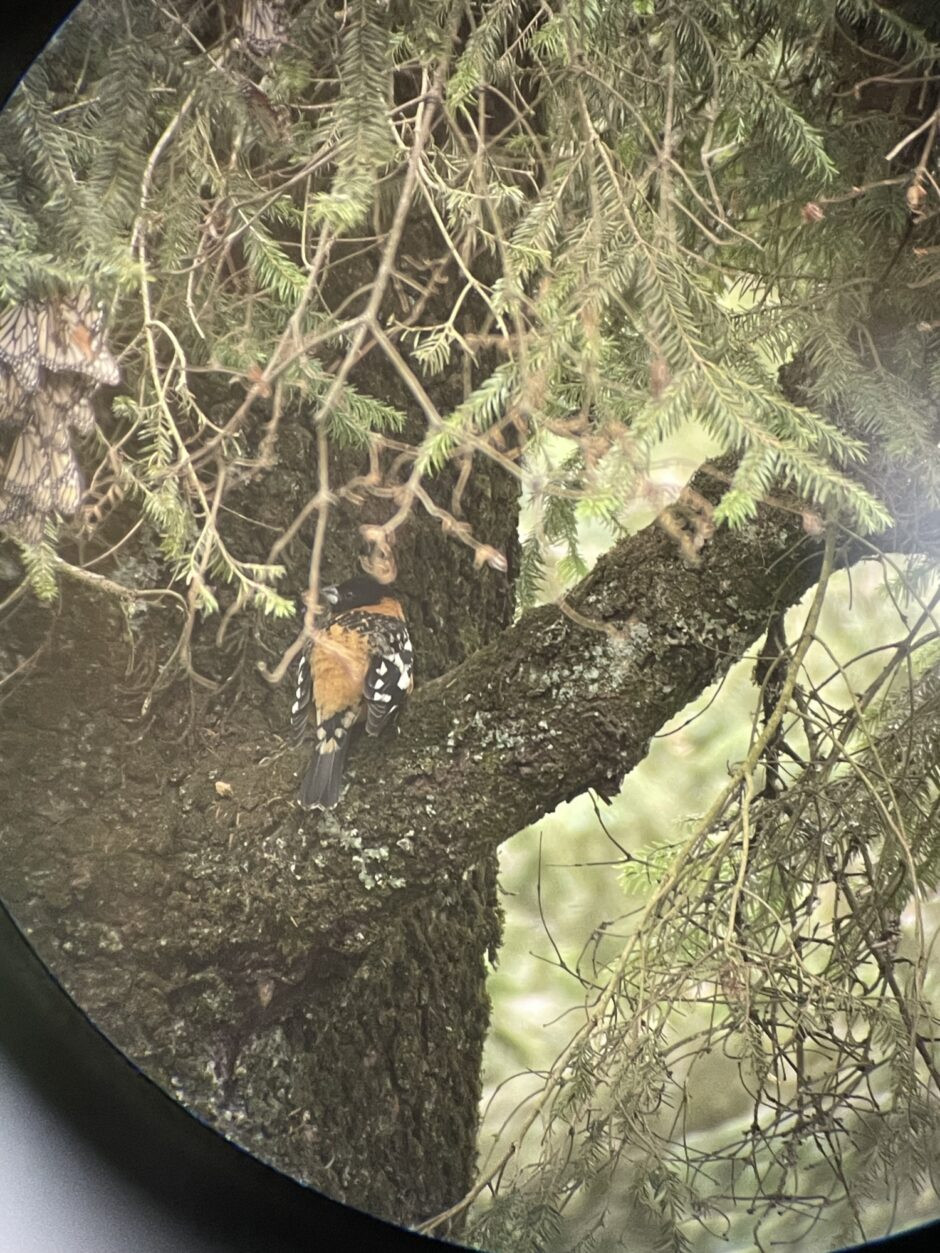 The Black-headed Grosbeak has the perfect coloration to gobble up countless monarch butterflies! And we thought that nothing would eat them because of the milkweed toxins in their bodies!
The Black-headed Grosbeak has the perfect coloration to gobble up countless monarch butterflies! And we thought that nothing would eat them because of the milkweed toxins in their bodies!
FAQ About Monarch Butterflies in Mexico
1. What is the Monarch Butterfly Biosphere Reserve?
The Monarch Butterfly Biosphere Reserve is a protected area in central Mexico where monarch butterflies overwinter.
2. Why do monarch butterflies migrate to Mexico?
Monarch butterflies migrate to Mexico to escape the cold winters of North America.
3. When is the best time to see monarch butterflies in Mexico?
The best time to see monarch butterflies in Mexico is from November to March.
4. Where in Mexico do monarch butterflies overwinter?
Monarch butterflies overwinter in the oyamel fir forests of the Monarch Butterfly Biosphere Reserve in the states of Michoacán and Mexico State.
5. What are the main threats to monarch butterflies and their migration?
The main threats include deforestation, climate change, and loss of milkweed habitat.
6. How can I help protect monarch butterflies?
You can help by planting milkweed, reducing pesticide use, and supporting conservation organizations.
7. What is the significance of the oyamel fir forests?
The oyamel fir forests provide a unique microclimate that protects monarch butterflies during the winter.
8. Are there LGBTQ+-friendly destinations near the Monarch Butterfly Biosphere Reserve?
Yes, Mexico City, Morelia, and San Miguel de Allende are LGBTQ+-friendly destinations within a reasonable distance.
9. What should LGBTQ+ travelers consider when visiting the monarch butterfly region?
LGBTQ+ travelers should research local laws and customs and exercise discretion in more conservative areas.
10. Where can I find more information about LGBTQ+ travel in Mexico?
You can find more information on gaymexico.net.
